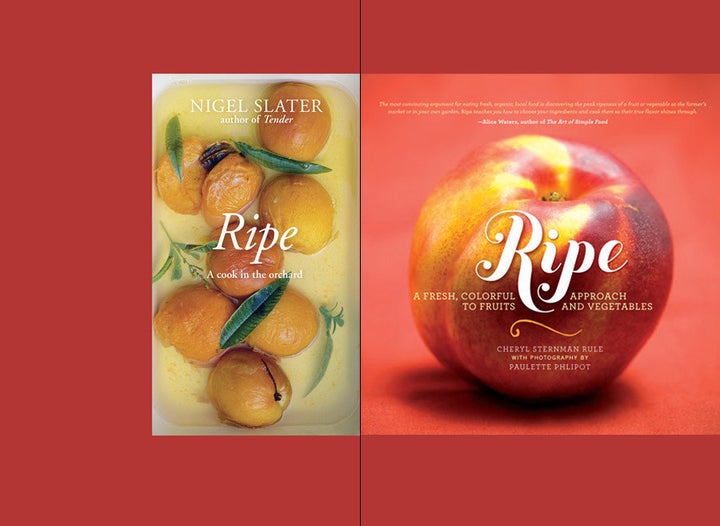
For Jonathan Lovekin, ripe is "the jewel-like color and light reflecting off a golden caramelized quince. For Paulette Phlipot, it's "the teensy little hairs on a raspberry."
Lovekin and Phlipot, both food photographers, celebrate the physical beauty of produce in their new books -- different books that share the same title: Ripe.
The books owe much to the produce-centric essays and recipes by their authors. Lovekin photographed Ripe: A Cook in the Orchard by beloved English cook and writer Nigel Slater. Phlipot came up with the idea of arranging produce tonally -- by color -- with Ripe: A Fresh, Colorful and Approach to Fruits and Vegetables, written by food blogger extraordinaire and IACP winner Cheryl Sternman Rule. In both cases, though, the images will make you want to bite the pages.
Lovekin approaches produce as "quite classical, a still life." He's provided the gorgeous images for Slater's books and articles as well as the sexy veggie photography for Plenty by Yotam Ottolenghi.
Both Slater and Ottolenghi show fruits and vegetables a good time. Both "style and think about how they want their food presented, they've kind of resolved that bit. I find the framing and light," says Lovekin, speaking from his studio in London. "With Nigel, I tend to be softer and quieter. Yotam's food is very different, it's sharper and brighter."
Though Lovekin effortlessly turns eggplant into object d'art, he's less into cooking and eating. "I like the idea of Wittgenstein -- he had the same thing every night," he says.
"I grew up in the '60s and '70s in England. Food wasn't a force. We didn't have a family where we would all sit down at a meal, where a meal was important. That's why I love the idea of food as a communal, cultural thing," says Lovekin. "I'm always searching for community. But I like being on the outside of it, looking in."
Phlipot, on the other hand, approaches food from "the inside. I look at it as a living object. It won't look the same tomorrow or in three or four hours. With produce, I feel the living aspect of it. You think it's a still life because it doesn't run away, but it's changing."
Lovekin is London-chic. Phlipot is "small town Idaho." She, too, does a lot of work with chefs, but prefers photographing -- and eating -- fruit and vegetables in their "organic, clean, simple, quiet" state. "When I work with produce, cutting it up for dinner, I notice details I would normally overlook when first picking it up at the market. I enjoy translating that excitement and elevating the produce to a new, different level in order to get people to stop and ponder and hopefully be motivated by the images." The radishes in Ripe come straight from her garden.
"Nigel brought me out into the garden," says Lovekin. "I would have always taken them inside and treated them more as objects."
Unlike Lovekin, Phlipot's parents loved to cook and eat and took delight in introducing their children to all kinds of food. They made it "an adventure." A dedicated vegetarian, Phlipot's sharing that sense of adventure with her 17 month-old daughter Cassidy. "We're having so much fun with it. She's wanting to try what we're eating -- even a spicy curry, she'll try it and likes it."
Even Lovekin, an indifferent eater, appreciates produce for its sheer design value -- its color, texture, shape. "Something green with luscious gradations of color is easier to photograph. Meat is quite difficult. It's brown blobs."
Lovekin and Phlipot's approaches may differ but their lenses agree -- fruits and vegetables are exciting, alluring, ravishing. And ripe.
Spiced Apricot Couscous
from Ripe: A Cook in the Orchard by Nigel Slater, photographed by Jonathan Lovekin
"The apricot takes nicely to a little spice, and not just the sweet cinnamon stick and pinks-scented clove but the cardamom pod and chile too. All the flavors it was brought up with."
So writes Slater in this recipe that typifies the easy grace he brings to his dishes. So easy, one hopes he wouldn't mind me suggesting that absent fresh apricots, you can substitute a small handful of chopped dried ones, so you can make this dish at any time.
large shallots - 2 (or a medium onion)
butter - a thick slice
half a cinnamon stick
green cardamom pods - 6
dried chile flakes - a good pinch
apricots - 7 ounces (200g)
golden raisins - a handfulfor the couscous
couscous - scant 1 cup (150g)
olive oil - a tablespoon
hot vegetable stock - 1 cup (250ml) harissa paste - 2 tablespoons
a preserved lemon
cilantro - a small bunchPeel and chop the shallots, then cook them in the butter over medium heat for ten minutes or so, until soft and golden. Stir in the cinnamon stick, cardamom pods, chile flakes, and a grinding of salt and black pepper. Halve, pit, and chop the apricots and add to the pan with the raisins and a cupful of hot water. Leave to simmer gently for ten to fifteen minutes, until the apricots are truly soft.
Put the couscous in a heatproof bowl with the olive oil. Pour over the hot stock and cover with a lid. leave for ten minutes, then fluff up the grains with a fork, stirring in the harissa paste and the finely chopped skin of the lemon (you can discard the inner pulp, if you wish). Fold the cooked apricots into the couscous, then chop the cilantro and fold it in too.
Serves 8.
